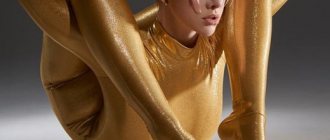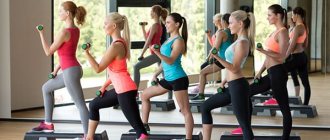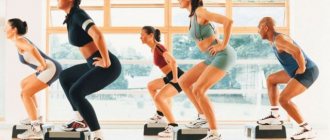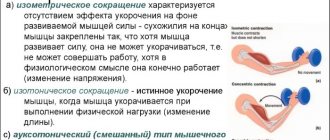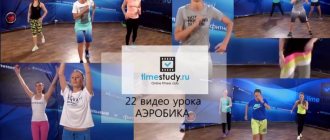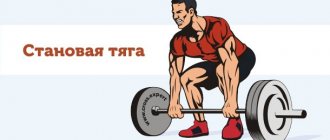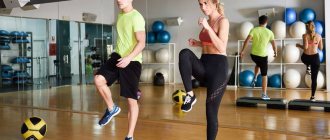© Prostock-studio — stock.adobe.com
Share:
It is difficult to list all types of aerobics. Every day there is a new lesson. In the 90s we boxed, and in the 2000s we started dancing Zumba en masse. In recent years, fans have been jumping on trampolines, spinning bicycle ergometers, doing high-intensity circuits and intervals, and pole dancing.
The industry is doing everything to ensure that every person effectively combats physical inactivity. Mostly people come to aerobic classes to lose weight. Although technically they can just walk down the street or park. And this will also be a cyclic load that develops endurance. Completely synonymous with what they do in a fitness club, but with a lower heart rate.
Aerobics[edit | edit code]
Aerobics
is a form of exercise that combines rhythmic aerobic exercise with stretching and strength training to improve all elements of fitness (flexibility, muscle strength and cardiovascular fitness).
Usually aerobics is done to music and in a group under the guidance of an instructor (fitness trainer), although it can be done alone and without musical accompaniment. Aerobics returns with fashion
Features
:
- Exercise for the muscles of the whole body
- Uses multiple joints
- Open or closed kinetic chain depending on the nature of the exercise
- Overcoming your own body weight
- The load can be constant or variable
- Sometimes requires special and fairly developed skills
- For all levels - from beginner to advanced
Classic aerobics
Belonging to the most common training complex, this most ancient type of aerobics contains a simple and not complex set of general exercises.
Often, training in this course is a combination of jogging and bouncing, skipping and stepping, swinging and skipping, performed to music with a certain rhythm.
History[edit | edit code]
Sports psychologist Kenneth Cooper is considered the founder of aerobics. He owns both the very name of this type of activity and the development of exercises for it. His 1970 book The New Aerobics highlighted the benefits of this type of exercise. In addition, it included evidence-based aerobic training programs such as running, walking and cycling.
Aerobics gained particular popularity at the end of the 20th century. In 1982, Jane Fonda released the first videotape of her workouts, which sold 17 million copies. No other video recording in history has had such a circulation.
In 1989, Jean Miller proposed a new type of aerobics - step aerobics, which differed from all others in the use of a small elevated platform that created increased load during the workout.
Although aerobics is no longer as popular today as it was at the end of the 20th century, it has a wide variety of forms to suit all needs.
Sports
Actively popularized types of sports aerobics are a successful and useful combination of different elements of gymnastics and acrobatics, dancing and aerobic exercise.
Sports activity programs are widely used in the methodology of preparing athletes for upcoming competitions and in school and preschool institutions.
Directions and types[edit | edit code]
There are many areas of aerobics, which, as a rule, are based on cardiovascular exercises. Take aerobics with martial arts elements (tai-bo, kataboxing) or indoor cycling (Johnny Spinning). Dance aerobics classes are usually conducted in group classes accompanied by music and under the guidance of a qualified instructor. Many aerobics schools have moved away from the 1970s "no pain, no gain" philosophy and are incorporating aspects such as stabilizing muscle strengthening and strength training, including the use of exercise balls and weights.
Directions and types:
- Water aerobics
- Combat aerobics (kibo and tai-bo)
- Hydroaerobics
- Pump aerobics (body pump)
- Cycle aerobics
- Slide aerobics
- Step aerobics
- Strength aerobics
- Dance aerobics
- Fitball aerobics
Dance
The most common types of dance aerobics are constantly being updated with new and interesting directions; now there are more than 70 options:
- street dance or hip-hop aerobics;
- Latin and salsa, retro and jazz;
- funk and disco, body ballet.
The variety presented depends on dance styles and directions, the main movements of which become the basis for the exercises of the training sessions.
Benefit[edit | edit code]
Regular cardio training strengthens the heart and lungs, normalizes high blood pressure and cholesterol levels, burns calories, stimulates lymph flow, and strengthens the immune system. During aerobic exercise, serotonin levels increase and endorphins are released, the hormones of joy that help relieve stress and anxiety.
There are classes designed so as not to overload the joints with jumping and sudden movements. While performing the exercises, you constantly stand on the floor with at least one foot. Such classes are suitable for pregnant women, elderly people, those who are significantly overweight, or those recovering from an injury.
Water aerobics
To implement such a program, you will need to create certain conditions, because classes must be conducted in an outdoor or indoor pool.
The aquatic environment allows you to simplify or increase the level of difficulty when playing certain groups of movements, which allows you to control the level of load and its correct distribution.
Where to start[edit | edit code]
If you are a beginner or poorly prepared physically, study for several months in a preparatory group and only then move on to classes with more complex programs. In large groups, little attention is usually paid to proper technique, so the training either does not bring any benefit, or the effect is such as overtraining. The fact is that the instructor is not able to keep track of everyone and establish contact with each participant. If you have any physical problems that may be aggravated by exercise, you should inform the group leader in advance so that he can select safe and effective exercises for you. Read more: group fitness.
Step aerobics
A step platform is used as the main sports equipment, providing the correct technology for reproducing movements.
The mobility technique is based on performing measured steps and jumps; the platform is additionally used during the implementation of the load on the abs, arms, and lower body.
Injury Prevention[edit | edit code]
Source:
Muscle Stretching for All Sports
.
Author
: Kudryavtsev A.
Publishing house.
: Eksmo, 2012.
Aerobics
- this is an excellent workout for the cardiovascular system, but if done incorrectly, it can lead to overload: injuries to the lower back, hips, calves, ankles and feet; sprains, tendonitis, stress fractures. Using ankle weights, dumbbells, or steps can increase the likelihood of injury. The fitness industry, recognizing the risk, has developed low- or no-contact programs. Now you can see aerobics sections where clients do standing chest-deep in water, “water aerobics.”
Look for those sections that practice on a special surface that sags a little under your feet. Working out for hours on a concrete floor every day is a recipe for trouble. Aerobics-specific shoes can give you some support and cushioning and help you maintain proper foot alignment, but the shoes cannot fully compensate for the hardness of the running surface. Carpeting doesn't help. The shock absorption system of the foot itself is amazing, but constant shock will be transferred from the foot up the ankle to the thigh and back. At first, you will feel sore feet and tired legs. But if there is no rest from these constant impacts on the floor, something may become excessively tired, then a sprain will appear, then a fracture.
Protect yourself from injury by preparing for every workout with active isolation stretching. Pay attention to unfamiliar movements that put your body in new positions. Another risk is a collision with subsequent injury. For example, if you take a boot-scoot step on your left leg, and everyone else on your right, you can end up with a very unpleasant pile of scratches and bruises. You can also injure yourself by falling off or stepping off the step platform while performing a move. It's best to take classes according to your level and don't rush to move on to a more difficult level until you feel confident at your current level. Choose an experienced aerobics instructor. Before enrolling in a section, ask the instructor for a certificate and talk to other students. We want you to have fun while being safe in the hands of a qualified and experienced professional!
Aerobic dancing is used as an addition to training, but for some dancers the aerobic program is the basis. If you are one of these dancers, then you need to supplement your training with strength exercises and stretching.
Drink plenty of fluids before and after your workout. Be sure to warm up before and cool down after. Do not skimp on purchasing special shoes for dancing with elements of aerobics. And have fun!
Fitness aerobics
All existing types of fitness aerobics promote effective figure correction and help quickly recover from weight gain.
Active work in this direction allows you to strengthen muscles and ligaments, develop a new level of coordination of movements and spatial orientation, harmoniously influencing all metabolic processes.
Wellness
The types of health aerobics that exist today help to normalize internal processes in the body; they are divided into the following areas:
- yoga aerobics to strengthen and restore the respiratory system and relax muscle tissue;
- flex aerobics, which helps to actively stimulate the development of flexibility of muscles of different groups and connective tissue;
- Slide aerobics, sliding technique and persistent work on the muscles of the inner thighs help strengthen them.
Such exercise options are necessary for those who want to get the maximum healing effect and evenly distribute the load without unnecessary overexertion.

